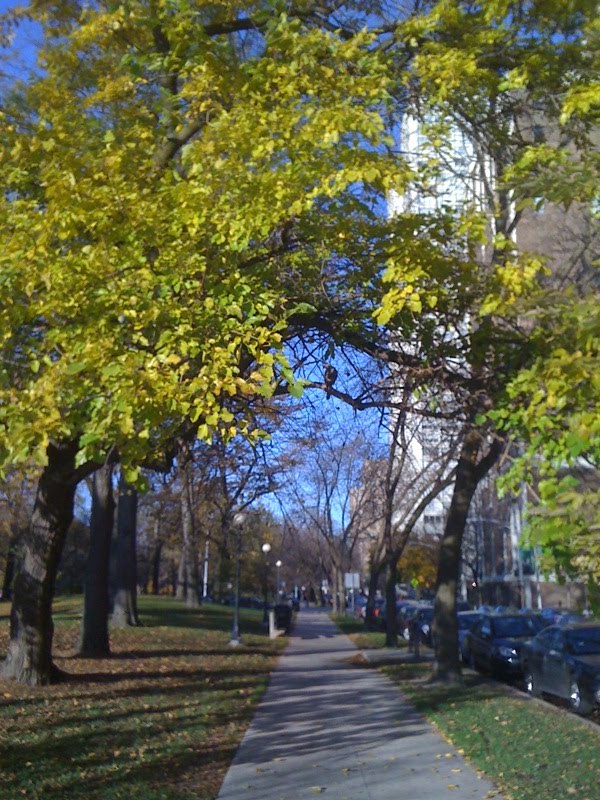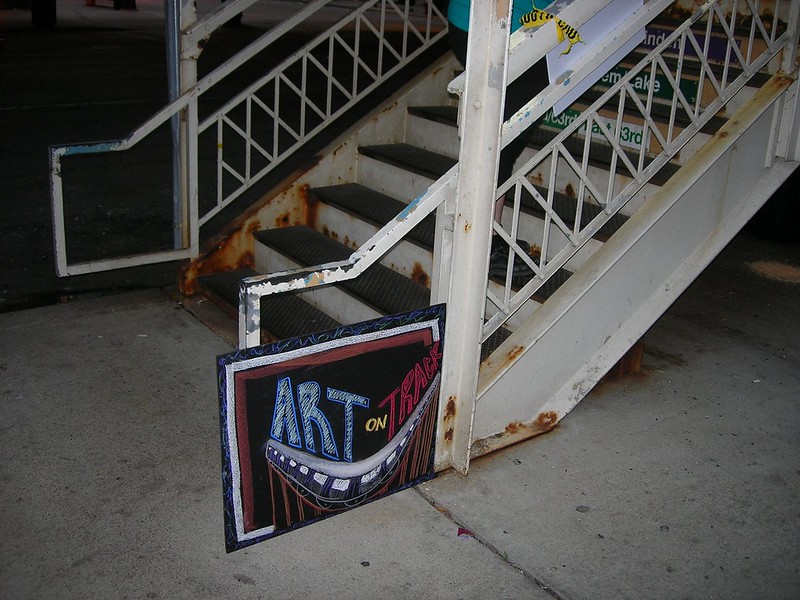These photos are from a Friday trip with J. to the the Chicago Botanic Garden to see Wonderland Express, about which I knew nothing. The walk through Chicago in natural miniature was followed by dinner with another friend at Don Roth’s Blackhawk in Wheeling and an evening of art and conversation over coffee. A walking tour of Tuscany or Scotland would be grand, but in the meantime life, or at least my life, doesn’t get better than this.
Tag Archives: Chicago
Hawkeye

This morning at South Shore Drive and 56th Street I heard the autumn crows cawing in fine form. As I turned onto the sidewalk along the park, something flew up in front of me; my impression was of a mourning dove, although I hadn’t picked up the characteristic whrrrr! of its takeoff. When I looked up, I was surprised to see that what I’d flushed was a small hawk.
I’ve heard of hawks in Jackson Park/Wooded Isle, but have not seen one except perhaps high in the sky. Here was one perched in the tree in front of me, so of course I couldn’t find the iPhone in my bag as I searched frantically and wished for a better camera (and that I weren’t on the way to work). As I hunted, I couldn’t tell if the bird had flown off or was still there looking at me quizzically. Finally, I dug out the iPhone, input the code, launched the camera application, and took the best photo I could with what I had.
The hawk flew to the ground. Irrationally, I thought it might be injured as it hopped awkwardly around, so I walked toward it, then it took refuge on a lower branch of a bush. Probably feeling threatened by my persistent interest, it flew off. When last I saw it, it was skimming the grass, then soaring high overhead. I still wondered if it had a leg injury — another one of my impressions, like that of a mourning dove.
Fly free, friend.
Lincoln Park Zoo docent program slated for extinction
Mary Schmich left a voicemail to interview me for an August 30 Chicago Tribune article, but I didn’t get the message in time to meet her deadline. I sent the following letter to the Chicago Tribune and to Schmich. As soon as I get some post-surgery energy, I’ll be writing more here.
To the editor:
As a former Lincoln Park Zoo docent during the 1990s (I was 29 when I joined the program), I read “Zoo docents fading from landscape” by Mary Schmich (August 30, 2009) with interest. During my docent service, I received laudatory letters from donors, ovations after animal presentations, and kudos for tours; helped develop a popular “Escape to the Tropics” weekend during the winter; talked to families who delighted in both the interaction and the information; participated in numerous revenue-generating programs such as family workshops; and delivered in countless other ways on what was one of the four prongs of the zoo’s mission: Education. And I was one of more than 200 people of various ages and professional backgrounds, including not only retirees, but working teachers, college instructors, lawyers, nurses, dietitians, executives, Ph.D.s, and so on, doing the same — all on a volunteer basis. To paraphrase the Peace Corps slogan, “It was the best job I ever loved.” I left it with regret for personal reasons.
According to a zoo document quoted by Schmich, “the antiquated volunteer utilization model . . . does not enhance the zoo’s strategic initiatives and often does not set up volunteers for success.” Neither “strategic initiatives” nor “success” is defined. I admit I felt successful when, for example, families paying to attend workshops requested me as their tour guide and when I could persuade children — and their parents — to overcome their fear of snakes to touch one and find out that reptiles are animals, just like us. It’s hard to believe that the docent program, and docent-guest interactions like these, didn’t benefit millions of zoo visitors during the docent program’s nearly 40-year history. Surely the education mission and the visitor experience remain important to Lincoln Park Zoo.
To find out how to enhance its strategic initiatives, Lincoln Park Zoo might consider redesigning the docent program with help from its sister institutions. For example, Prospect Park Zoo (Brooklyn, New York) “is welcoming applications for its Docent Program . . . Docents lead group tours, interpret exhibits, present biofacts and other touchables at Discovery Stations, assist in our interactive Discovery Center, work at zoo special events, and teach visitors how to interact with alpacas and sheep at our barn area. Docents who successfully complete Live Animal Handling Training are also eligible to present short Live Animal Encounters to the public, teaching children and families about animals from the Zoo’s collection of education animals.” According to the Saint Louis Zoo, “Our docents are volunteer Zoo educators who are dedicated to teaching schoolchildren and the general public about wildlife, ecosystems and conservation. In sharing their knowledge and enthusiasm about our Zoo animals, they help increase our visitors’ caring attitude toward nature. Docents are critical to the successful operation of the Zoo’s Education Department and the greater zoological community.” Closer to home, “Brookfield Zoo docents will host the next National Association of Zoo & Aquarium Docents (AZAD) Conference September 7–12, 2010.” (The 1993 national AZAD conference was hosted by Lincoln Park Zoo docents.) These, and many other zoos and aquariums with thriving, successful docent programs, can provide the kind of guidance that Lincoln Park Zoo isn’t able to obtain from a consultant focused purely on business.
Renowned primatologist and herpetologist Russell A. Mittermeier Ph.D., the president of Conservation International and the only working field biologist to head a major international environmental organization, says, “The dedication and efforts of docents are a major contribution to the education of society. Their volunteer services are exerting a real impact, particularly on this country’s young people who show a growing interest in natural history and conservation.” This fits in perfectly with the Obama administration’s nationwide service initiative.
During this severe economic downtown, when Lincoln Park Zoo has had to slash budget and staff, it seems counterintuitive to squeeze volunteers and downsize volunteer programs. And it would be deeply regrettable if Lincoln Park Zoo were to dismiss as an “antiquated model” one that so many zoos and aquariums, and environmental leaders such as Mittermeier, have embraced as essential to conservation education and human appreciation for our fellow earth travelers.
Sincerely,
Diane Schirf
We back the bid and you can too
I first noticed this proclamation displayed prominently in the building across the street, the pillars of which had been painted in colors complimentary to the logo, then in my building, then seemingly everywhere downtown. This ubiquitous display of Olympic love, it turns out, had been carefully orchestrated to coincide with a visit by the International Olympic Committee.
Who is the “we”? I wondered.
The answer to that in this case is no mystery — every business that needs to stay in the plus column of Mayor Richard M. Daley’s ledger. When Da Mare’s cruising, you want to make sure you, your business, and your building conform to his mantra, even if you personally pay your taxes in Naperville or don’t care one way or the other. It’s the wise thing to do.
I live in Chicago, I care, and those signs don’t speak for me. I am not part of the universal “we.”
I don’t back the bid. I don’t think I’m alone.
I’m sure many Chicagoans and suburbanites crave the excitement, prestige, and economic stimulus it’s claimed that the Olympics would bring to Chicago. I don’t. I also don’t desire the long-term disfigurement of places like Jackson and Washington Parks for the sake of a two-week event whose benefits are debatable.
I’m jaded enough to wonder if Daley, during whose reign the classic Soldier Field was transformed into a futuristic glass toilet bowl where the regular folks are huddled together on one side of the field while the wealthy and influential take the other, envisions the Olympics as the capstone of his legacy. Perhaps he has Chicago’s best interests at heart, at least when they coincide with his.
Rootless, I’ve remained emotionally detached from Chicago, even as I approach my 30th year here. I missed the regime of the first Mayor Daley and have never been interested in the Machine, whether yesterday’s powerhouse or today’s more sophisticated and streamlined version. But a recent incident in Hyde Park is a measure of how I feel about the government of the city that works. A local restaurant was shut down by city inspectors for not having the right kind of Dumpster, or for having an outdated one. J. and I had the same thought: “Sorry, we gotta shut ya down until ya get the right kind of Dumpster. Say. I gotta card here of a guy who sells the kind of Dumpster ya need, the kind in the city ordinance. He’ll fix ya up good. He’s the mayor’s [insert relationship here].”
That’s how the city of big shoulders works. And that’s part of why “we” back the bid, although no one asked us, just like they didn’t ask us if we wanted the runways at Meigs Field rendered useless by enormous Xs gouged into them late on a Sunday night. That’s just the way it is in “My Kind of Town.” The mayor’s way or the highway.
So, no offense, but I hope I don’t see you in 2016, unless you’re here for the zoo, the aquarium, the planetarium, the museums, the parks, the universities, or the professional sports — all things that Chicagoans are and should be proud of.
2016 would be my 37th year here.
Help.
Flushed with fondue and red wine
State of the art fair
Saturday J. and I went to the 57th Street Art Fair, arriving around 50 minutes before closing. I have a one-sided love-dislike relationship with art fairs:
On the love side:
- They’re outdoor community events, an ancient human tradition I adore. I love the idea of a crowd coming together under the open sky for an event that’s important to individual participants and to the community. In this case, the community is not only geographic, but artistic: creators, patrons, buyers, browsers (like me).
- At a good art fair, there are amazing varieties of materials, styles, techniques, themes, uses, and so forth. Someone selling conventional wall paintings may be parked next to an artist who crafts jaw-droppingly lovely inlaid wood bowls, and both may be near another artist whose etchings are whimsical and witty. We saw everything from knitted and crocheted pins to erotic statues of fat women (a personal favorite for some reason).
- Sometimes I find something I love that I can both afford and use, for example, niobium earrings from Sozra at the Ann Arbor Street Art Fair. It was there I also found a three-dimensional clock for J., which I think featured a cat in a tiled kitchen and an evocative seascape seen in the background through a window.
In the dislike column:
- Much of the art doesn’t appeal to me. A couple of nicks in a keystone of polished wood. Colorful, childlike scrawls. Abstract anything. Garish colors. Urbanscapes. In some cases, it doesn’t appeal to my eye or my taste; in others, it seems bland or unoriginal or uninspired; in others, it seems like a cynical cheat. Corollary: I have no cohesive taste or style, so I would not be able to choose art, decorative or fine, to create a beautifully designed interior space. I would end up with a hodgepodge of styles and colors, leaning toward the cool end of the spectrum.
- I have no room. Being a pack rat junk collector, leaves little room for displaying art properly. Having a cat who likes to chew, bat, and knock things over is another factor.
- I have no money. Let‘s say that I had control over my collection of miscellaneous 1970s kitsch, souvenirs, and other junk. Still, I can‘t afford much that I like, for example, whimsical etchings (three figures) and erotic sculptures (five figures) — and wouldn‘t they complement one another?
The weather forecast called for rain, but at least on Saturday the clouds held off. There weren‘t the crowds I remember from a hot, sunny day a few years ago. It may have been the threat of rain and the relative coolness of the air, the proximity to closing time, or the state of the economy, but there was a lack of people and energy, I felt.
J. and I have very different browsing styles, which can be challenging. And I didn‘t see anything that stopped me in my proverbial tracks. I should have gone with less of a hope of finding something because I was disappointed in my mission.
One thing made me smile, though, despite it being fundamentally a little sad. One artist was accompanied by a beautiful little dog with little or no use of its hind legs. When the man went for a walk, he strapped the dog‘s back legs onto a little car with wheels. While those legs dangled uselessly from their straps in the air, his good front legs pulled him and his wheels along. The dog, who otherwise spent his time lying on a blanket behind the display, seemed content enough with this arrangement, strange as it may at first look.
We went to 57th Street Books with its 20 percent sale for members, and such were my mood, purse, and space issues that I didn‘t buy anything. This has to be a first.
Not surprisingly, Medici on 57th was crowded, with a 15-minute wait, but the spinach and goat cheese pan pizza was worth it. It gave us the strength to start going through some of J.‘s papers. Even though they aren‘t mine, filling a bag with the nonessential ones and dropping it down the chute was satisfying and cathartic.
Fall asleep to wind and rain; wake up to wind and snow
Fall of an elder (tree)
[I meant to post this in May. Spring has come and gone and will come again.]
The tree on the southwest corner of 56th Street and Hyde Park Boulevard took a long time to die.
First, the leaves of one limb would turn yellow, dry up, and fall off, and another would follow, and another. By last autumn, one limb of leaves remained, and it was dying. Of course, when winter came it didn’t matter — it looked like all the living but leafless tress around it.
It made me sad to think of spring arriving, knowing that at least one prominent old tree would still be a stark hulk against the blue skies after all its brethren had burst into bud.
That’s why I was relieved a few weeks ago to find a crew cutting it down. By the time I arrived at the bus stop across the street, they had cut its limbs off, and one man had sawed through about half the trunk. I had shown up in time for the crucial moment. One of the crew cleared the other southbound lane and halted traffic. I wondered how they were going to control its fall, then I noticed that the ropes tied to the tree were anchored to a bar on the front of one of the trucks. As the truck slowly reversed, the tree tumbled. It seemed almost like a gentle fall rather than a hard crash. I could imagine that the spirit of the dead tree was relieved of its burden at last.
By the next morning, all that remained was the stump and some wood chips missed during the cleanup. Within a few days, the stump had been cut down and removed, and all that is left today is a large, roughly circular patch of wood chips, the kind the Chicago Park District and landscapers sometimes put on the bare patches under healthy trees.
I miss that tree, and the one on the southeast corner behind the bus stop that was struck by lightning or torn apart during one of the spate of micro-bursts that have devastated so many trees here in recent years. I miss their shade and their guardianship of the ad hoc footpath through the park and of the bus stop, each a little like the sole remaining pillar of an ancient gate. When I look at the wood chips that mark the location of the one and the three spindly bushes that encircle the patch left by the other, I feel like I am visiting the grave sites of respected, beloved elders. Both look like scars that will take a long time to heal.
I wonder if their spirits ever leave, or if they too still mourn.
Autumn today at Promontory Point
Art on Track, Chicago

Saturday evening, after stuffing ourselves at Bonjour Bakery Café, J. and I hopped on the bus and went downtown for Art on Track, which I had learned about from Puppet Bike. Art on Track consisted of eight elevated cars circling the Chicago Loop, with each car representing a local gallery. This is the type of idea that draws people, especially young ones, to the city; you’d never find an energized bow to creativity like this in Arlington Heights. Kudos to the CTA for being open to the idea and to those who worked with them to make it happen.
Art on Track was surprisingly well organized, especially for a first-time event. A small chalked sign at the bottom of the Adams/Wabash elevated stairs let us know that we were in the right place, and extra CTA staff directed us to a table where we paid $5 apiece for admission bracelets. Another employee whisked us through the gates, and one on the platform made sure people knew which trains on the various routes had come in so hapless travelers wouldn’t find themselves on Art on Track. One of them gave us an idea of when Art on Track was due at this starting point.
The Art on Track crowd was not difficult to spot, bracelets and buttons aside. With a few middle-aged and older exceptions, they were young, pierced, and tattooed, and most were Caucasian. Probably many if not most are involved in the School of the Art Institute of Chicago. Far from being driven geniuses toiling in lonely garrets, Chicago’s young artists seem to be highly social. I wonder if the young Manet, Monet, Gauguin, and others were as much of an obvious type to their neighbors.
A “You are here” graphic in each car showed where we were in relation to the rest of the train, and which car was occupied by which studio. I think we began two or three cars from the back. The train stopped at each platform in the circuit so participants could change cars.
Our primary objective was the Peter Jones Studio and Gallery car, but we made it onto every car, some twice or more. The most memorable car featured pallets of grass strewn with flowers and guitarist/singers performing 1960s-style music on topical subjects (along the lines of a Dylan). Another car was decorated with garish posed photos of trans performers and particularly evil-looking clowns who made any Batman movie version of the Joker look tame. In a third car, musicians sporting face and body paintings of death images sang what I guessed to be Mexican songs. Painted paper plates were affixed to the ceiling of one car, and others had hanging (punching?) bags and other material pieces. Of course, there were some paintings, and Alan Emerson Hicks had brought at least two of his melted plastic sculptures.
In such narrow, crowded space, it was difficult to get a good look at anything, including artists’ names, but perhaps that was not the point. Maybe the idea was simply to acknowledge the growing young artist community spawned by the Art Institute’s expanding school and to energize them with their own event — not as big as Looptopia, but still important enough to be sanctioned by the city.
Early on, I observed a student/freelance photographer/makeup artist approach and older man, apparently a gallery owner or representative. Pleasantries were exchanged, followed by business cards. That was the point as well.
If I were to plan an Art on Track II, I would do at least one thing differently; I would dedicate one or two cars to the musicians and performers and have them take turns. Aside from the space constraints, I found that they distracted me from the non-lively arts. I would also add something for children, at least for the first hour or two, something that would appeal to families and add some diversity.
On another note, at one point I kneeled on my left knee on a seat without thinking and was reminded suddenly and painfully that I fell on it hard last Tuesday; it’s still black, blue, and green. I’ve been so worried about my teeth that I haven’t paid attention to my knee, which for some reason didn’t bother me as much as usual on the elevated stairs. I felt it today; I don’t know how to describe it, but the kneecap feels “squishy” compared to my solid right kneecap. It occurred to me today that I should make an appointment with my physician to see if an X-ray is in order. Aside from soreness to the touch (explained in part by the impressive bruise), the oft-insulted left knee seems to be functioning, but clearly it’s not like the other, and I suppose now is the time to see if anything can be done to minimize the long-term effects. Somehow I see a knee replacement in my future . . .



